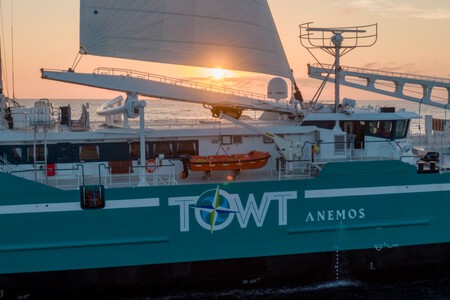Most experts agree that one of the best ways to address the problem of climate change is to drastically reduce emissions. greenhouse gas emissions. Under this premise, initiatives such as the European Green Pact have emerged or China’s energy transition plan. Now, if we want to achieve the set goals on time, we will have to make many changes to the world we live in.
Maritime transport, a vital part of global trade, is responsible for approximately 2% of CO2 emissions, According to data from the International Energy Agency. We have reached this point because most cargo ships They move with heavy fuel oil (HFO). HFO is a type of fossil fuel derived from petroleum. also associated with pollution from spills.
Changing the way we move goods
About a month ago we discussed the Danish shipping company Maersk’s first foray into nuclear energy. Now it’s time to talk about another interesting initiative. A French firm called Towt has just completed the first transatlantic voyage with “the largest cargo ship in the world“It is about Anemosan experimental vessel that promises to leave a much smaller carbon footprint than a traditional container ship.
Anemos left the port of Le Havre in northern France on August 16 and arrived in New York on September 3. As reported by Radio France InternationaleThe sailboat made its journey at an average speed of 10 knots (18.5 km/h), which is somewhat slower than ships powered by fossil fuels, whose average speed is 14.2 knots (26.2 km/h). Its load capacity has also been limited to 1,200 tons of products.

Before this trip, Anemos was an interesting concept, a series of ideas and technology that were kept afloat in France awaiting a real-world test. Now that The first important journey is overTowt has enough information to allow his cargo sailing ship project to continue developing. The sailboat, it should be noted, has little to do with traditional sailing ships, but incorporates more than interesting elements.


First of all, we can mention that the masts are not made of wood, but have been built from carbon fibre to make them lighter. The sails are deployed with a remote control system that reduces the amount of manual work that the seven sailors in its crew have to do. The 81-metre-long boat uses specialised software and satellite connectivity to adjust its course to make the most of the wind.
It’s no secret, however, that weather conditions are not always optimal. Towt has taken this into account by adding a backup propulsion system integrated by two diesel-electric enginesWhile it may not have been ideal, the ship needed to start its engines shortly after leaving France because the wind was not strong enough, although the company says the last 10 days of the voyage were powered by sail.

Anemos is part of a planned fleet of eight ships that will be able to transport 200,000 tonnes of goods a year, saving around 40,000 tonnes in carbon emissions. We will have to wait and see if this idea will finally become a reality. For now, the products transported by Anemos may include a label which informs consumers that what they just purchased arrived from Europe on a sailboat.
Images | Towt
At Xataka | Is it feasible to protect ourselves from climate change with a giant umbrella? Some researchers believe so
At Xataka | India already has its new submarine with nuclear missiles. It is not enough to intimidate China






![[Img #74661]](https://thelatestnews.world/wp-content/uploads/2024/12/The-power-of-ultrasound-150x150.jpg)






![[Img #74661]](https://thelatestnews.world/wp-content/uploads/2024/12/The-power-of-ultrasound-300x200.jpg)


Add Comment